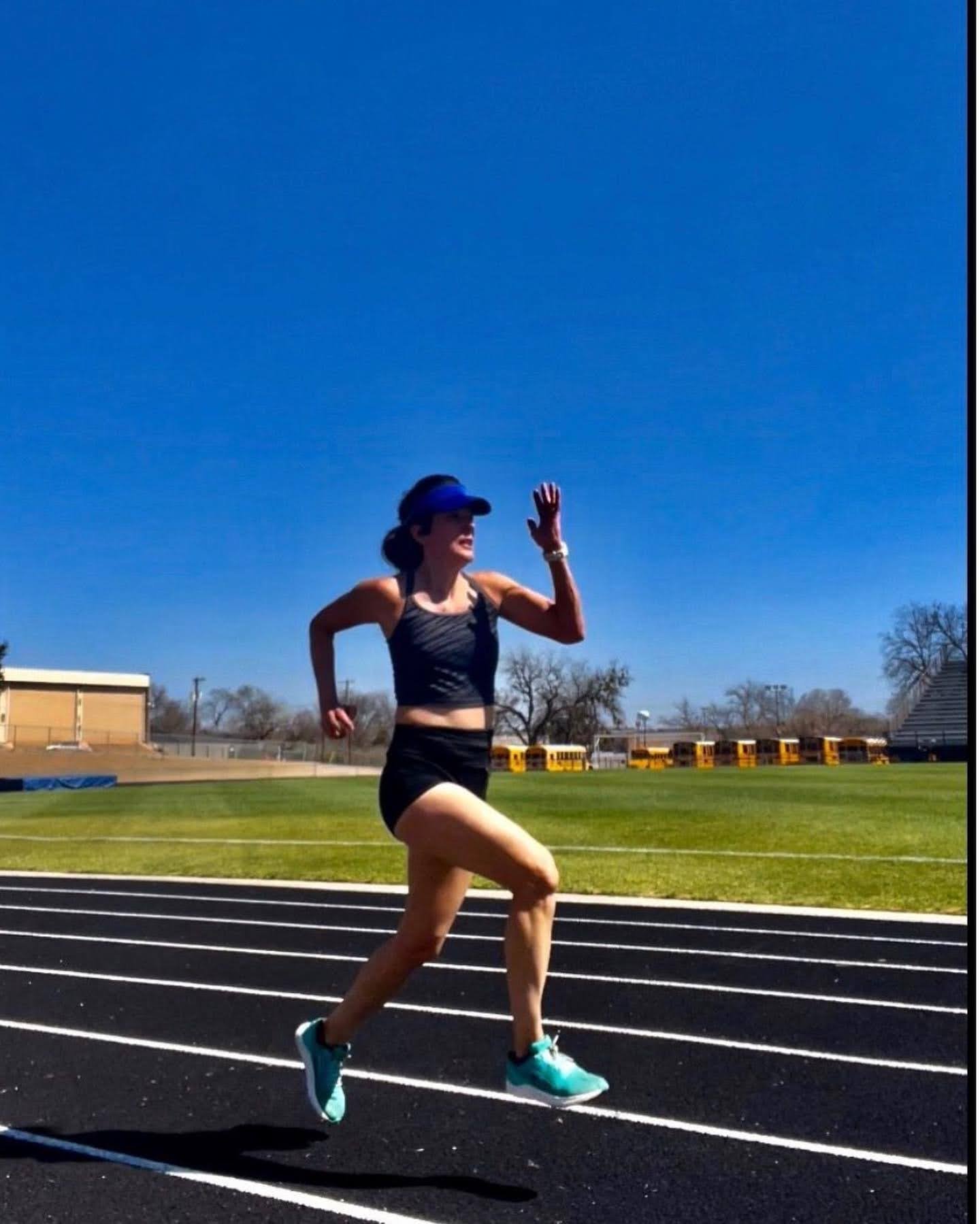I first took up running over a decade ago as a means to lose weight; I had no idea it would change my whole life. Running burns more calories per minute than most any other exercise, so it seemed like an obvious path to weight loss. If your goal is to lose weight, a running plan can be a part of your fat loss strategy. What I didn’t know when I started running is that the training and nutrition surrounding running for weight loss looks different than running for performance goals.
If your goal is to run a marathon or improve your 5K time, you may be surprised that there is no guarantee of weight loss in pursuit of performance running goals. People often gain weight while marathon training (I wrote a post on gaining weight during marathon training if you want to check it out here. It happens.)
While it’s fantastic to chase multiple goals, the way you need to train and how you eat will look different depending on your goal. If your goal is to run a marathon, lose 15 pounds, get six pack abs, and deadlift twice your bodyweight, those goals require different training stimulus to achieve, so it’s difficult to pursue all of them at the same time. You can try — but your results won’t be as dramatic than if you took them on one at a time.
LASER FOCUS ON YOUR TRAINING GOALS: PERFORMANCE OR WEIGHT LOSS?
You can have multiple goals; you won’t have as much success if you try to pursue them all at once. Choose one goal, laser focus on the steps to achieve it, then work on the next one. One goal at a time will bring better results than chasing four related goals at once.
RUNNING FOR FAT LOSS
When your goal is fat loss, one of the most important factors to focus on is maintaining a calorie deficit, you achieve this by burning more calories in a day than you consume. You can do it by either eating fewer calories, burning more calories in exercise, lifting weights to increase metabolism over time or the best strategy, a combination of all.
CARDIO BURNS CALORIES
While running burns more calories per minute than most any of exercise, our body adapts to the stresses we place upon it. As our body gets more efficient at the activity, it feels more comfortable. It’s the reason you were huffing and puffing on the first mile you ever ran and could barely make it around the corner, and now you can efficiently run three miles while chatting with your running partner.
The bad news is when it feels easier; over time it becomes less effective at calorie burning. You either have to run longer or run faster to provide new stimulus. It’s the reason why if you run the same pace and distances month after month your weight loss can stall, your body had adapted to the exercise and isn’t burning as many calories as when you started.
STRENGTH TRAINING BUILDS MUSCLE (AND METABOLISM)
If your goal is fat loss or performance, I highly recommend a combination of running and resistance training. If you lift weights, you can improve your running performance, help prevent injuries, and potentially improve your metabolism. When you lose weight, it should be a priority to maintain or build your lean muscle tissue. If you lose weight by running a lot of miles, but also lose muscle, that can stall weight loss (or cause a rebound in weight gain). With less muscle, your body needs fewer calories to function day to day — not great for permanent fat loss.
RUNNING FOR WEIGHT LOSS
Eat in a calorie deficit; consume fewer calories than burned in a day, which can make you feel hungrier during the day, and could affect performance on longer runs or high-intensity runs. It takes some experimenting to find what a calorie deficit means to you; you can’t trust the calories burned numbers on your Fitbit. It’s also worthy to note that a more significant calorie deficit isn’t better. Too drastic of a cut can cause your body to rebel. A small and steady decrease brings the best long term results. Don’t be in a hurry; patience wins this race.
Plan the consumption of whole-food carbohydrates around training, before and after workouts on training days. Focus on healthy carbs including oatmeal, fruit, vegetables, sweet potatoes and brown rice. Limit or reduce white bread, pasta, pastries, cookies, cereal, ice cream, processed protein bars, and packaged salty snacks.
Consume whole food protein sources to help preserve lean muscle. Most athletes need at least .5 to 1 gram of protein per pound of body weight. It depends on your current muscle mass, your training protocol, and your current weight. Experiment with increasing whole food protein at each meal, it’s especially important to help retain muscle if you are training to lose weight.
Run a combination of steady-state runs, high-intensity intervals, and threshold (tempo) runs. When your body becomes efficient at a pace and distance, you must change variables to continue to stimulate the body to lose weight; Run longer, run faster, run on an incline or stairs, and vary your paces and rest periods, for best weight loss results.
Plan a sleep schedule to get seven to eight quality hours of sleep per night. When you don’t get enough sleep appetite-controlling hormones can cause increased cravings to make you feel hungrier.
Plan two to three 30-minute full body resistance training sessions per week. Use weights that feel heavy enough that you can complete at least six but not more than twelve reps. If you can easily go up to 20 reps with that weight, then increase the load and reduce the reps. Choose compound exercises that strengthen multiple muscle groups at once, like squats, deadlifts, lunges, pushups, and rows for the most bang for your workout buck.* It’s ok to start with light weights or no weights while you learn the movements and get comfortable with new exercises. Only add heavier weights once you are sure you are performing them with perfect form.
Work to reduce stress outside of exercise. Exercise is a stress on the body. It is positive stress, but if you have a lot of outside stress (family, work, lack of sleep, poor nutrition, excessive caffeine, etc.) elevated stress hormones can stall weight loss. Mediate, pray, walk, read, write, call a friend, get a massage, spend time in nature, or schedule alone time to help reduce overall stress. More is not always better when it comes to exercise. When life stress is low then high-intensity workouts are appropriate. When life stress is high, decrease intense workouts.
RUNNING FOR PERFORMANCE
When you train for a long distance running or speed these training sessions can cause an increase in appetite. Running performance is usually increased while eating at calorie maintenance or a slight calorie surplus. Underfueling can negatively affect performance.
Generally speaking, although individual variances do exist, if you are training for long-distance running, 400-600 grams per day of carbs may be optimal for performance. Reducing carbohydrates too low may affect long distance running training. Focus on whole food carbohydrates for the best results. Experiment to see what works best for you.
Never increase the volume (time spent running) and the intensity (the speed) in the same week. Choose one or other. The injury will negatively affect performance if it sidelines your training.
Increase the amount of time you run each week slowly. Too much too soon is the number one cause of injury and overtraining.
Every four weeks take a step back in total volume for recovery.
Allow proper recovery between hard workouts, which varies from athlete to athlete based on training age, actual age, and genetics. If you don’t allow for recovery, it can affect your results, stall progress, and possibly lead to injury. Don’t underestimate the importance of rest and recovery.
Work to get at least eight hours of sleep per night. If a non-athlete needs seven, the athlete needs at least eight. Most of our body’s recovery processes happen during sleep. If you’re not recovering properly, your body can’t improve. When you’re training, sleep is even more critical.
Don’t neglect resistance training. A strong core, back, glutes, quads, and hamstrings will help you run faster, maintain pace, maintain proper form, and reduce the chance of injury.
Break your goals into training periods. For example: Spend three months training for fat loss, then switch to a long distance training protocol, then a training plan to increase speed, then perhaps a strength or aesthetic goal program if desired. Separating goals into periods will give you better individual results for each target. You can cycle through your goals each time to achieve better results than you would if you attempted them all at once.
Did you like this post? Do you know someone who might benefit? It helps me when you share with your friends and followers on Facebook, Twitter or Pinterest.
Questions? I’d love to help.













